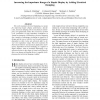Free Online Productivity Tools
i2Speak
i2Symbol
i2OCR
iTex2Img
iWeb2Print
iWeb2Shot
i2Type
iPdf2Split
iPdf2Merge
i2Bopomofo
i2Arabic
i2Style
i2Image
i2PDF
iLatex2Rtf
Sci2ools
HAPTICS
2005
IEEE
2005
IEEE
Increasing the Impedance Range of a Haptic Display by Adding Electrical Damping
This work examines electrical damping as a means for improving haptic display performance. Specifically, electrical damping, like its mechanical counterpart, can significantly reduce the occurrences of limit cycle oscillations at high impedance boundaries in virtual environments. Furthermore, electrical damping has a number of advantages including its simplicity of design and the ease at which it can be made frequency dependent so that it does not adversely affect a device’s low impedance range. This work examines the theoretical behavior and practical application of frequency dependent electrical damping as it applies to haptic displays. Data is presented illustrating a significant increase in the range of virtual wall behaviors that a one degree-of-freedom device is capable of displaying when electrical damping is added.
Dependent Electrical Damping | Electrical Damping | Haptic Displays | HAPTICS 2005 | Virtual Reality |
| Added | 24 Jun 2010 |
| Updated | 24 Jun 2010 |
| Type | Conference |
| Year | 2005 |
| Where | HAPTICS |
| Authors | Joshua Mehling, J. Edward Colgate, Michael A. Peshkin |
Comments (0)

